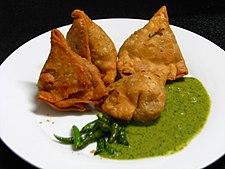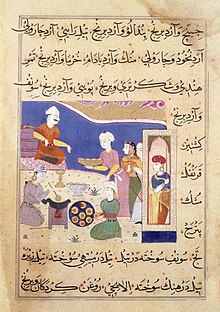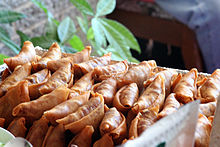Samosa
For the Nicaraguan dictator(s), see: Somoza
 | |
| Alternative names | samsa, somsa, sambosak, sambusa, samoosa, singada, samuza |
|---|---|
| Region or state | Indian Subcontinent, Central Asia, Western Asia, Horn of Africa, North Africa, South Africa |
| Main ingredients | Maida, potato, onion, spices, green chili, cheese, meat |
| Variations | Chamuça |
A Samosa is a fried or baked pastry with a savory filling such as spiced potatoes, onions, peas, lentils, ground lamb or chicken. The size, shape and consistency may vary, but many versions are triangular. Samosas are often accompanied by chutney.[1] They are a popular appetizer or snack in the Indian Subcontinent, Southeast Asia, Central Asia and Southwest Asia, the Arabian Peninsula, the Mediterranean, the Horn of Africa, North Africa, and South Africa.
Name variation
Samosa (/səˈmoʊsə/; Template:Lang-hi) is generally used in the Indian Subcontinent and South-east Asian countries. Other names are used in other areas: (Template:Lang-ar sambūsak), Template:Lang-bn, sing-ra in Assamese, Template:Lang-or, Template:Lang-pa, Template:Lang-gu, Template:Lang-kn, Template:Lang-ml, Template:Lang-mr, Persian: سمبوسه, Template:Lang-ta, Template:Lang-ur, sambusak, samsa (pronounced [ˈsamsə]) or somsa in Turkic Central Asia (Template:Lang-kk, [sɑmsɑ́], Template:Lang-ky, [sɑ́msɑ];, Template:Lang-uz, [sɒmsa], Template:Lang-ug, [sɑmsɑ́]), as well as Turkey (Template:Lang-tr), sambusa among Arabs, Eritreans, Ethiopians, Somalis (Template:Lang-so) and Tajiks (Template:Lang-tg), sanbusé among Iranians (Template:Lang-fa), samuza (Template:Lang-my, IPA: [sʰəmùzà]) among Burmese or chamuça in the Lusophone world.
Etymology
The word "samosa" can be traced to the Persian سنبوساگ sanbosag.[2] The pastry name in other countries also derives from this root, such as the crescent-shaped sanbusak or sanbusaj in Arab countries, sambosa in Afghanistan, samosa in India, samboosa in Tajikistan, samsa by Turkic-speaking nations, sambusa in parts of Iran, and chamuça in Goa, Mozambique and Portugal.[citation needed] While they are currently referred to as sambusak in the Arabic-speaking world, Medieval Arabic recipe books sometimes spell it sambusaj.[3]
History

The samosa has been a popular snack in the Indian Subcontinent for centuries. It is believed to have originated in Central Asia (where it is known as samsa[4]) prior to the 10th century.[5] Abolfazl Beyhaqi (995-1077), an Iranian historian has mentioned it in his history, Tarikh-e Beyhaghi.[6] It was introduced to the Indian subcontinent in the 13th or 14th century by traders from the region.[2]
Amir Khusro (1253–1325), a scholar and the royal poet of the Delhi Sultanate, wrote in around 1300 that the princes and nobles enjoyed the "samosa prepared from meat, ghee, onion and so on".[7][8]
Ibn Battuta, the 14th-century traveller and explorer, describes a meal at the court of Muhammad bin Tughluq where the samushak or sambusak, a small pie stuffed with minced meat, almonds, pistachio, walnuts and spices, was served before the third course, of pulao.[8][9]
The Ain-i-Akbari, a 16th-century Mughal document, mentions the recipe for qutab, which it says, “the people of Hindustan call sanbúsah”.[10]
Regional varieties
Different regions which have inherited the dish have significantly different ways of preparing it.
Central Asia

In Uzbekistan, Kazakhstan and Kyrgyzstan, samosas are almost always baked and never fried. The dough can be a simple bread dough, or a layered pastry dough. The most common filling for traditional samosa is lamb and onions, but beef, chicken, and cheese varieties are also quite common from street vendors. Samosas with other fillings, such as potato or pumpkin (usually only when in season), can also be found.
In Central Asia, samosas are often sold on the street as a hot snack. They are sold at kiosks, where only samosas are made, or alternatively, at kiosks where other fast foods (such as hamburgers) are sold. Many grocery stores also buy samosas from suppliers and resell them.
Indian Subcontinent

The samosa contains a maida flour shell stuffed with some filling, generally a mixture of mashed boiled potato, onion, green peas, spices and green chili;[11] The entire pastry is then deep fried to a golden brown colour, in vegetable oil. It is served hot and is often eaten with fresh Indian chutney, such as mint, coriander or tamarind. It can also be prepared as a sweet form, rather than as a savory one. Samosas are often served in chaat, along with the traditional accompaniments of yogurt, chutney, chopped onions, coriander, and chaat masala.
The Bengali version of the samosa is called a Singara and is normally much smaller than the standard Indian samosa.
In Hyderabad, India, a smaller version of the samosa with a thicker pastry crust and mince-meat filling referred to as lukhmi is consumed, as is another variation with onion fillings.
In South India, samosas are slightly different, in that they are folded in a different way more like Portuguese chamuças, with a different style pastry. The filling also differs, typically featuring mashed potatoes with spices, fried onions, peas, carrots, cabbage, curry leaves, green chillies, etc.. It is mostly eaten without chutney. Samosas in South India come in different sizes, and fillings are greatly influenced by the local food habits. Samosas made with spiced mashed potato mixture are quite popular in the South Indian states of Andhra Pradesh, Karnataka, and Tamil Nadu.

In Pakistan, samosas of Karachi are famous for their spicy favour, whereas samosas from Fasilabad are famous for being unusually large. They are eaten with chutney and side portion of onion salad. Another special variety available in Karachi is called kagazi samosa after its thin and crispy pastry. The filling is usually mixed vegetable; however, the meat version also remains very popular. Another version, popular in eastern Punjab, consists of samosas with side dishes of mashed, spiced chickpeas, onion and coriander salad, as well as various chutneys to top the samosas.
They are called samusa in Burmese, and are an extremely popular snack in Burma.
The local equivalent of samosas in Indonesia are known as pastel, usually filled with eggs, ground beef or chicken.
Horn of Africa

Samosas are a staple of local cuisine in the Horn of Africa (Somalia, Eritrea, Ethiopia, Djibouti), where they are known as sambusa. While they can be eaten any time of the year, they are usually reserved for special occasions, such as Ramadan, Christmas or Meskel.
Israel
In Israel, a sambusak is a semicircular pocket of dough filled with mashed chickpeas, fried onions and spices. It is associated with Sephardic Jewish cuisine and Arabic Palestinian cuisine. An Israeli sambusak is not as spicy as the Indian version.[12]
Portuguese-speaking countries

In Goa and Portugal, samosas are known as chamuças, usually filled with chicken, beef, pork, lamb or vegetables, and generally served quite hot. They are an integral part of Goan cuisine and Portuguese cuisine.
Chamuças are also relatively common in Brazil and several former Portuguese colonies in Africa, such as Cape Verde, Guinea-Bissau, São Tomé and Príncipe, Angola, and Mozambique.
English-speaking countries
Samosas have become popular in the United Kingdom, South Africa, Kenya, Canada,[13][14] and the United States. They may be called samboosa or sambusac, and in South Africa they are often called samoosa.[15] Frozen samosas are increasingly available in grocery stores in Canada, the United States, and the United Kingdom.
While samosas are traditionally fried, many Westerners prefer to bake them, as this is more convenient and healthier. Variations using phyllo,[16] or flour tortillas[17] are sometimes used.
See also
References
- ^ Arnold P. Kaminsky; Roger D. Long (23 September 2011). India Today: An Encyclopedia of Life in the Republic. ABC-CLIO. p. 151. ISBN 978-0-313-37462-3. Retrieved 22 April 2012.
- ^ a b Lovely triangles "Hindustan Times", August 23, 2008.
- ^ Rodinson, Maxime, Arthur Arberry, and Charles Perry. Medieval Arab cookery. Prospect Books (UK), 2001. p. 72.
- ^ Uzbek samsa Consulate General of Uzbekistan in New York City. Retrieved March 13, 2008.
- ^ Davidson, Alan (1999). The Oxford Companion to Food. Oxford University Press. ISBN 0-19-211579-0.
- ^ Beyhaqi, Abolfazl, Tarikh-e Beyhaghi, p. 132.
- ^ Savoury temptations The Tribune, September 5, 2005.
- ^ a b "Origin of the Samosa". The Samosa Connection. samosa-connection.com.
sambusak: "minced meat cooked with almonds, pistachios, onions and spices placed inside a thin envelop of wheat and deep-fried in ghee".
- ^ Regal Repasts Jiggs Kalra and Dr Pushpesh Pant, India Today Plus, March, 1999.
- ^ Recipes for Dishes Ain-i-Akbari, by Abu'l-Fazl ibn Mubarak. English tr. by H. Blochmann and Colonel H. S. Jarrett, 1873–1907. Asiatic Society of Bengal, Calcutta, Volume I, Chapt, 24, page 59. “10. Quṭáb, which the people of Hindústán call sanbúsah. This is made several ways. 10 s. meat; 4 s. flour; 2 s. g'hí; 1 s. onions; ¼ s. fresh ginger; ½ s. salt; 2 d. pepper and coriander seed; cardamum, cuminseed, cloves, 1 d. of each; ¼ s. of summáq. This can be cooked in twenty different ways, and gives four full dishes.”
- ^ Samosa recipeSamosa recipe from Gujarat. Retrieved November 26, 2010.
- ^ "Gems in Israel: Sabich - The Alternate Israeli Fast Food".
- ^ "Lineups threaten to stall Fredericton's hot samosa market". CBC.ca. January 30, 2007. Retrieved 25 May 2010.
- ^ Fox, Chris (Wednesday July 29, 2009). "Patel couldn't give her samosas away". The Daily Gleaner. dailygleaner.com. p. A1. Retrieved 25 May 2010.
{{cite news}}: Check date values in:|date=(help) - ^ South African English is lekker!. Retrieved June 13, 2007.
- ^ Fennel-Scented Spinach and Potato Samosas. Retrieved February 6, 2008.
- ^ Potato Samosas. Retrieved February 6, 2008.
External links
- The Ismaili Nutrition Centre Chicken Samosa recipe includes health and nutritional information and a visual guide to folding samosas.
- Bihari cuisine
- Middle Eastern cuisine
- Arab cuisine
- Syrian cuisine
- Jordanian cuisine
- Iraqi cuisine
- Saudi Arabian cuisine
- Israeli cuisine
- Palestinian cuisine
- Savoury pies
- Sephardi Jewish cuisine
- Indian snack foods
- Pakistani cuisine
- Punjabi cuisine
- Sindhi cuisine
- Pashtun cuisine
- Balochi cuisine
- Kashmiri cuisine
- Uttar Pradeshi cuisine
- Hyderabadi cuisine
- Burmese cuisine
- Dumplings
- Goan cuisine
- Pakistani fast food
- Pakistani snack foods
- Indian fast food
- Somalian cuisine
- Kazakhstani cuisine
- Malaysian cuisine
- Singaporean cuisine
- Tatar cuisine
- Bengali cuisine
- Portuguese cuisine
- Central Asian cuisine
- Oriya cuisine
- Rajasthani cuisine
- Iranian cuisine
- Persian loanwords
